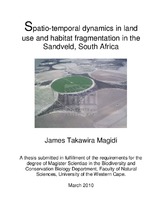| dc.contributor.advisor | Krug, Cornelia B. | |
| dc.contributor.advisor | Knight, Richard | |
| dc.contributor.author | Magidi, James Takawira | |
| dc.contributor.other | | |
| dc.contributor.other | Faculty of Science | |
| dc.date.accessioned | 2013-12-04T08:36:04Z | |
| dc.date.available | 2011/02/16 09:25 | |
| dc.date.available | 2011/02/16 | |
| dc.date.available | 2013-12-04T08:36:04Z | |
| dc.date.issued | 2010 | |
| dc.identifier.uri | http://hdl.handle.net/11394/2496 | |
| dc.description | Magister Scientiae (Biodiversity and Conservation Biology) - MSc (Biodiv and Cons Biol) | en_US |
| dc.description.abstract | This research assessed landuse changes and trends in vegetation cover in the Sandveld, using remote sensing images. Landsat TM satellite images of 1990, 2004 and 2007 were classified using the maximum likelihood classifier into seven landuse classes, namely water, agriculture, fire patches, natural vegetation, wetlands, disturbed veld, and open sands. Change detection using remote sensing algorithms and landscape metrics was performed on these multi-temporal landuse maps using the Land Change Modeller and Patch Analyst respectively. Markov stochastic modelling techniques were used to predict future scenarios in landuse change based on the classified images and their transitional probabilities. MODIS NDVI multi-temporal datasets with a 16day temporal resolution were used to assess seasonal and annual trends in vegetation cover using time series analysis (PCA and time profiling).Results indicated that natural vegetation decreased from 46% to 31% of the total landscape between 1990 and 2007 and these biodiversity losses were attributed to an increasing agriculture footprint. Predicted future scenario based on transitional probabilities revealed a continual loss in natural habitat and increase in the agricultural footprint. Time series analysis results (principal components and temporal profiles) suggested that the landscape has a high degree of overall dynamic change with pronounced inter and intra-annual changes and there was an overall increase in greenness associated with increase in agricultural activity. The study concluded that without future conservation interventions natural habitats would continue to disappear, a condition that will impact heavily on biodiversity and significant waterdependent ecosystems such as wetlands. This has significant implications for the long-term provision of water from ground water reserves and for the overall sustainability of current agricultural practices. | en_US |
| dc.language.iso | en | en_US |
| dc.publisher | University of the Western Cape | en_US |
| dc.subject | Change detection | en_US |
| dc.subject | Habitat Fragmentation | en_US |
| dc.subject | Landsat | en_US |
| dc.subject | Markov Models | en_US |
| dc.subject | Cell Automated Markov Analysis | en_US |
| dc.subject | Moderate Resolution Imaging Spectroradiometer | en_US |
| dc.subject | Normalised Difference Vegetation Index (NDVI) | en_US |
| dc.subject | Principal Component Analysis (PCA) | en_US |
| dc.subject | Remote sensing | en_US |
| dc.subject | Time Series Analysis | en_US |
| dc.title | Spatio-temporal dynamics in land use and habit fragmentation in Sandveld, South Africa | en_US |
| dc.type | Thesis | en_US |
| dc.rights.holder | University of the Western Cape | en_US |
| dc.description.country | South Africa | |

